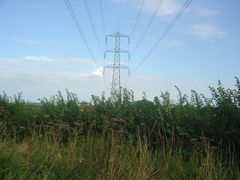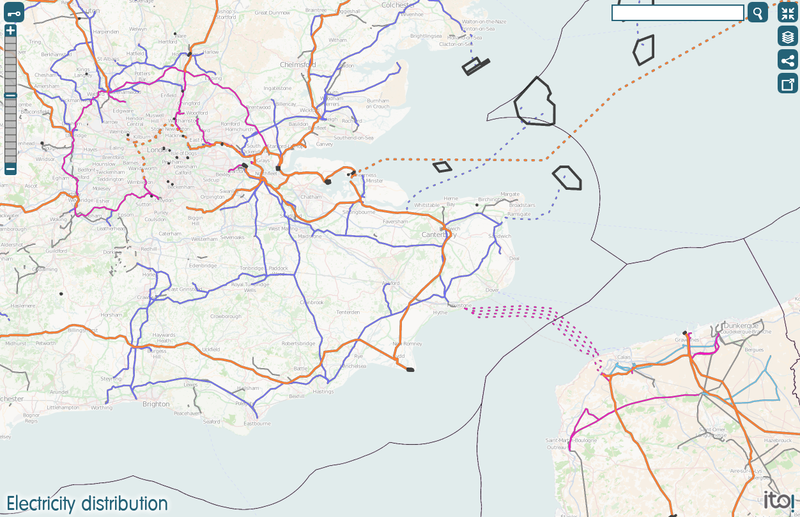ES:Energía

|
| Descripción |
| Usado para describir líneas de energía e infraestructura asociada. |
| Etiquetas |
La clave power=* se utiliza para identificar un extenso rango de instalaciones y características que se relacionan con la generación y distribución de energía eléctrica, incluyendo las líneas o tendidos eléctricos, centrales de generación de la energía, estaciones de almacenamiento y subestaciones. El Wikiproyecto Redes de Energía proporciona más detalles sobre proyecto de mapear los sistemas de distribución eléctricos.
Features
This table is a wiki template with a default description in English. Editable here.
Guidance
Very useful for navigation.
The number of wires in each cable can tagged using wires=single, wires=double or wires=quad. All towers also have one or more earth wires strung from the top.
United Kingdom
National Grid call the things "towers" as they're free-standing, but common usage seems to be "pylon"
In England and Wales, higher-voltage (>= 275kV) lines are operated by National Grid. Lower voltage lines are operated by distribution network operators (UK Power Networks, Western Power Distribution, etc) with regional scope. Different DNOs have different construction standards, so while the transmission network is consistent across the country, the distribution network has substantial design variations.
In the UK, each National Grid power line appears to have a two character identifier and each tower along that line appears to be numbered. For example ZM is the West Weybridge to Chessington line, and each tower is numbered ZM 1, ZM 2, etc. I propose that these be recorded, if known, for each tower with the ref tag. For example: power=tower, ref=ZM 35. Higher-voltage DNO lines use similar schemes, sometimes with three-letter line identifiers (e.g. PTC connects Burwell to Fulbourn Grid).
In the UK there is a hierarchy of power lines that is easy to identify. Most are identifiable over long distances which makes them useful for navigation. Other countries follow very similar schemes (not surprising as the design is constrained by the same physics and economics). Starting at the low-voltage end, we have:
- Wooden poles carrying four wires on small ceramic insulators, or bundles of insulated cables twisted together. These lines are usually 400 V between phases, which directly provide the domestic 230 V supply. Most of these follow roads and paths.
- Wooden poles with two or three widely-spaced bare wires on large insulators having one or two plates. These lines are 11,000 volts - often used for distribution in rural areas.
- Wooden poles with three bare wires on multi-plate insulators are 33,000 V or 45,000 V between phases - usually on higher and more substantial poles, sometimes poles are used in pairs and sometimes two circuits are run in parallel on the same poles.
- Metal towers carrying a set of single wires (usually three plus an earth wire on top) are 132,000 V. These are gradually disappearing.
- Towers with three or six double wires are 275,000 V
- Towers with three or six quadruple wires are 400,000 V
United States
The number of conductors (i.e. single, double, triple) is simply relevant to the current handling capacity, and not more or less likely to be seen for any particular voltage. Similarly, the number of 3-phase circuits (groups of 3 cables) is simply a matter of capacity required, since single-circuit paths are (somewhat surprisingly) much cheaper to construct - the cost of the cables themselves apparently being the most significant factor.
Japan
In Japan, see User:Nahainec/PowerLine.
France
See WikiProject Power networks/France
Philippines
Further information at WikiProject Power networks/Philippines
Power lines in the Philippines are operated by various companies and cooperatives. The National Grid Corporation of the Philippines (NGCP) operates both subtransmission (69 and 115 kV) and transmission lines (115 kV, 138 kV, 230 kV, 350 kV DC, and 500 kV), but utilities (e.g. Meralco, Visayas Electric Company, Davao Light) and electric cooperatives may operate subtransmission lines (69 or 115 kV) and distribution lines (usually 7.39 and 13.8 kV, or 20 and 34.5 kV). Some electric cooperatives only operate distribution lines, and depend on NGCP for subtransmission lines to feed their substations.
Power line locations may be on allocated right of way or along roads or railroads. Transmission lines usually run on separate right of way, but a few partially or completely running along roads or railroads. Subtransmission lines by NGCP typically run on separate right of way and some segments follow roads, but utility or cooperative-owned subtransmission lines are usually roadside, for easier access by work vehicles. Distribution lines are almost roadside and areas served by the lines are usually served by multiple distribution transformers (single-phase), like the common practice in most of Asia and the Americas. Smaller distribution substations (substation=minor_distribution) are primarily used on large users, like some government offices, malls, or condominiums, instead of a larger area, like residential areas, where multiple distribution transformers are used instead.
Voltages used are like those used in the United States, and the frequency is 60 Hz. The household voltage is 220 volts, 60 Hz. Transmission, subtransmission, and distribution grid voltages, however, differ by island group, region, and company/cooperative practice.
- Metro Manila and nearby provinces in Luzon (Meralco):
- Transmission: 230,000 volts,
- Subtransmission 115,000 volts
- Distribution: 34,500 volts, 20,000 volts
- Most of Luzon:
- 500,000 volts, 230,000 volts
- 69,000 volts
- 13,800 volts, 7970 volts
- Ilocos Region:
- 230,000 volts, 115,000 volts
- 69,000 volts
- 13,800 volts, 7970 volts
Rendering
The electricity overlay map view from ITO Map showing power=line according to voltage=* (red = 400 kV+, purple = 300-399 kV, light blue = 200-299 kV, green < 200 kV).

MapCSS style
A mapCSS stylesheet is available for josm.